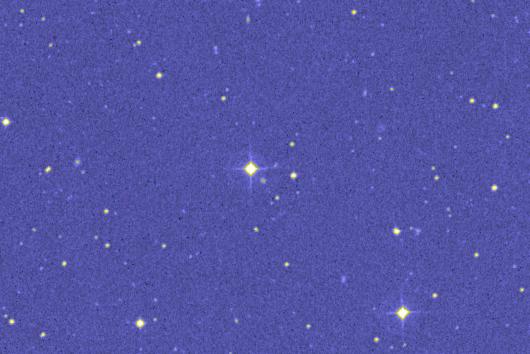Credit & Copyright: Digitized Sky Survey
Explanation:
Centered in this unremarkable, 1/4 degree wide
patch of sky in
the constellation Aquarius
is the star Gliese 876.
Gliese 876
is smaller than the Sun, only about 1/3 as massive,
and too faint to be seen without a telescope.
But it is known to be one of the
nearest stars, only 15 light-years distant.
Astronomers have just announced
findings that imply Gliese 876
has a planet at least 1.6 times as massive as Jupiter - making
this now one of the
closest suspected planetary systems.
Like many recent discoveries, this
planet's detection is not based on
direct imaging
but on spectroscopic measurements
of the periodic change in motion or
"Doppler wobble" produced in the
parent star as the planet orbits.
The Doppler wobble
of Gliese 876 indicates that its planet orbits
once every 61 days at an average distance of about 1/5 the
radius of the Earth's orbit.
1999 2000 2001 2002 2003 2004 2005 2006 2007 2008 2009 2010 2011 2012 2013 2014 2015 2016 2017 2018 2019 2020 2021 2022 2023 2024 2025 |
Yanvar' Fevral' Mart Aprel' Mai Iyun' Iyul' Avgust Sentyabr' Oktyabr' Noyabr' Dekabr' |
NASA Web Site Statements, Warnings, and Disclaimers
NASA Official: Jay Norris. Specific rights apply.
A service of: LHEA at NASA / GSFC
& Michigan Tech. U.
|
Publikacii s klyuchevymi slovami:
extrasolar planet - Gliese 876 - Planety u drugih zvezd
Publikacii so slovami: extrasolar planet - Gliese 876 - Planety u drugih zvezd | |
Sm. takzhe:
Vse publikacii na tu zhe temu >> | |
